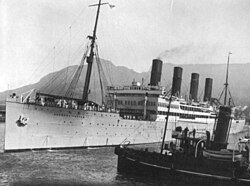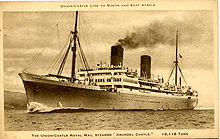Arundel Castle (ship)
|
The Arundel Castle in Cape Town
|
||||||||||||||||||||
|
||||||||||||||||||||
|
||||||||||||||||||||
|
||||||||||||||||||||
|
||||||||||||||||||||
The Arundel Castle (II) was a passenger ship put into service in 1921 , which was used for the British shipping company Union-Castle Line in passenger and mail traffic between Great Britain and South Africa . The ship, which was one of the largest and fastest on its route at the time, served as a troop transport during World War II and was scrapped in 1959. In almost 40 years of service, the Arundel Castle covered 3,475,565 nautical miles, 600,000 of them in times of war.
prehistory
At the beginning of the 20th century, the leading shipping companies became dominant in trade in the North Atlantic. One of these shipping companies was the British Union-Castle Line, which was founded in 1900 through the merger of the Union Steamship Company Ltd. ( Union Line , founded 1857) and Castle Mail Packet Company Ltd. ( Castle Line , founded in 1862). In 1910 the company put two new large steamers into service, the two 13,000-tonne Balmoral Castle and Edinburgh Castle . However, these two ships could still not keep up with the competition on the transatlantic route between Europe and North America.
In February 1913, the Union-Castle Line therefore ordered two new, large express liners from the Harland & Wolff shipyard in Belfast, Northern Ireland, for their passenger and postal services to South Africa. This was one of the most important trade routes for Great Britain at the time. Both ships were supposed to have a feature that only a few passenger ships had until then: four funnels. The plan was for at least one of the two ships to be operational by 1915. With the outbreak of World War I in 1914, however, the shipping company's plans were thwarted. Initially, it was assumed that the war would only last a few months. On November 6, 1915, the first of the two ships was keel laid. It was to be named Amroth Castle after the place in Pembrokeshire where the shipping company founder Owen Philipps, 1st Baron Kylsant, grew up.
At this point, however, it was already becoming apparent that the war would not be over anytime soon. It was therefore decided that the ship should be completed as a troop transport . Shortly afterwards it was decided to make an auxiliary cruiser (Armed Merchant Cruiser) out of the ship. All of these plans were not carried out without even starting work on the second ship. Construction was only continued after the end of the war. The ship, which had been laid down four years earlier, was launched in 1919. Instead of Amroth Castle , it has now been christened Arundel Castle . It was the second ship in the company's history to be named: As early as 1894, a new Castle Line building was named Arundel Castle . She was the 54th ship that Harland & Wolff had built since the Titanic .
The contract concluded before the war provided for a sister ship, so that the keel of Windsor Castle (18,967 GRT) was laid in the same year . Due to a lack of capacity at Harland & Wolff, this was completed at John Brown & Company , where the Lusitania and Mauretania were already created. Although the blueprints for both ships were drawn up before World War I, nothing was changed in the original design. Both ships received the intended four funnels, a dark, elegant hull and white-painted superstructures. They were two of only 14 four-funneled ships ever built and the only two of them that were not put into service for North Atlantic traffic between Europe and North America . They were also the only two four chimneys in the history of the Union Castle Line.
Early years
The 18,980 GRT steam turbine ship Arundel Castle was finally launched on September 11, 1919 at Harland & Wolff. It was 201.47 meters long and 21.95 meters wide. The facilities included a swimming pool , a gymnastics room and electrically operated elevators . In addition to the four funnels, the ship had two masts and two propellers and could reach a maximum speed of 17 knots. The ship, which could hold 1170 passengers, had enough lifeboats for all passengers and crew. Behind the fourth chimney were two davits that together could carry twelve lifeboats.
On April 22, 1921, the steamer ran under the command of Captain TJ Bremner on its maiden voyage to Cape Town . When East London was approached towards the end of the maiden voyage , the weather turned so bad that cargo could neither be unloaded nor picked up there. This resulted in East London being removed from the shipping company's timetable. The Arundel Castle was the first passenger ship since the 1914 Aquitania of the Cunard Line , which had four funnels. She and her sister ship Windsor Castle were the largest and fastest ships on the Union-Castle Line at the time.
In September 1923 Jan Christiaan Smuts traveled on board the Arundel Castle to the Imperial Conference in London . Later that year a seaman fell overboard and drowned. The passengers on this trip collected the then large sum of 350 pounds sterling for the bereaved. In November 1926, the Arundel Castle coming from Southampton collided with the 1400-ton coastal ship Maud Llewellyn . Neither ship was seriously damaged.
Modernization and late years
Both the Arundel Castle and her sister ship Windsor Castle proved to be profitable ships during the 1920s and early 1930s. However, in order to remain competitive and continue to appear modern, both ships were fundamentally rebuilt at Harland & Wolff at the end of 1936. The four chimneys were dismantled and replaced with two new, shorter ones. They also got a new bow , new turbines and new boilers.
As a result of the modifications, the hull was elongated by 25 feet (7.62 meters). In addition, there was a change from coal to oil combustion, which increased the previously possible cruising speed by three knots. The new design was praised around the world and was very well received. In September 1937, the Arundel Castle returned to passenger traffic after nine months.
During the Second World War , in which her sister ship Windsor Castle was lost, the Arundel Castle served mainly as a troop transport in the Mediterranean . Both ships took part in the Africa campaign. After the war ended, she brought British troops home from Germany via Sweden and others and from Marseille to Liverpool . It was not released back into merchant shipping immediately after the end of World War II, but retained its purpose for the time being.
It was not until 1949 that the Arundel Castle was sent back to its shipyard for urgently needed renovations. In September 1950 she returned to the service of the Union-Castle Line and was the last ship of the shipping company to return after the war. Seven years later, on April 12, 1957, she made her 200th crossing. On December 5, 1958, the Arundel Castle , which had been launched almost 40 years earlier, left Cape Town for its 211th and final voyage. In early 1959 it was sold to Hong Kong for demolition for £ 245,500 and sold to the Chiap Hua Manufactory Company Ltd. broken up in Kowloon .

